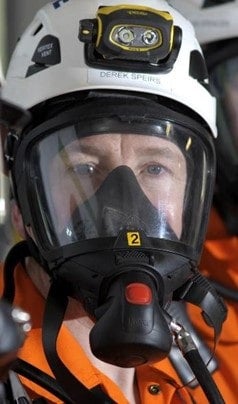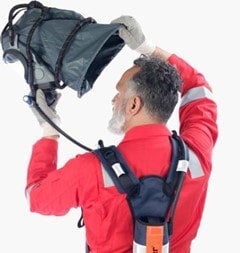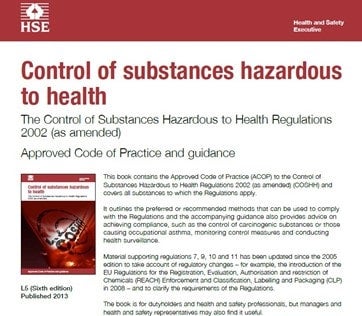It is an employer’s responsibility to control substances hazardous to health in their workplace and to prevent and adequately control exposure of staff to these substances.
However, this may not be possible to achieve in all circumstances and some work activities may result in harmful substances contaminating the air in the form of dust, mist, vapour, gas or fumes or require workers to work in areas where oxygen levels may become low.
What is Respiratory Protective Equipment?
Respiratory Protective Equipment (RPE) is a particular type of Personal Protective Equipment (PPE) designed to protect the wearer from breathing in harmful substances or from areas containing oxygen-deficient atmospheres when other controls are either not possible or insufficient on their own.
There are two main types of RPE:
- Respirators – filtering devices used to remove contaminants from the air being breathed in
- Breathing apparatus – provides an independent air supply to the wearer from surrounding environment i.e. via an air cylinder or compressed airline.
Respirators and breathing apparatus are commercially available with a range of facepieces which again fall under two broad categories:

- Masks – which are tight fitting facepieces (filtering facepieces, half and full facemasks). They rely on having a good seal with the wearer’s face. They can be used on both respirators and breathing apparatus.
- Hoods, helmets, visors, blouses, suits. These are loose fitting facepieces which rely on enough clean air being provided to the wearer to prevent contaminant leaking in. They are used only on fan-powered respirators and/or air-fed equipment.

When is Respiratory Protective Equipment used?
Respiratory protective equipment is at the bottom of the hierarchy of protective measures and should only be used after an acceptable case for their use has been established by way of an appropriate risk assessment.
The Confined Spaces Regulations stipulates that where RPE is provided or used in connection with confined space entry or for emergency or rescue, it should be suitable for the purpose for which it is intended, i.e. correctly selected and matched both to the job and wearer. For most cases, breathing apparatus would provide the standard protection for entry into confined spaces. Any RPE should comply with the Personal Protective Equipment (EC Directive) Regulations 1992 (displaying a “CE mark”), or where these provisions are not appropriate, be of a standard or to a type approved by HSE.
RPE should only be used:
- where inhalation exposure risk remains after other reasonable controls have been put in place
- while putting control measures in place
- for emergency work or temporary failure of controls where other means of control are not reasonably practicable
- for short-term or infrequent exposure, such as during maintenance work, where other controls at the source of the exposure are not reasonably practicable.
RPE should:
- provide the wearer with effective protection from inhalable hazards present in the surrounding environment
- be suitable for the intended use
Keeping equipment safe
COSHH regulations require Respiratory Protective Equipment to be the last line of protection. RPE only protects the wearer and if it is used incorrectly, or is poorly maintained, it is unlikely to provide the required protection. It can also be uncomfortable to wear and may interfere with work, which can lead to incorrect use.
COSHH Regulation 9 states that RPE must be maintained in “an effective state, in efficient working order and in good repair”.

In addition, RPE must:
- be examined at periods of at least once a month, or more frequently under severe conditions. However, where it is used infrequently against low toxicity substances, then the interval may be extended to every 3 months.
- be kept clean.
- be CE-marked or of an approved type/standard approved by HSE
- be used by properly trained people who are supervised
- be properly stored, cleaned and checked regularly
Training in RPE
Wearers should be given both initial, and at least annual refresher training, in the safe use of the chosen RPE device.
Training given should include:
- Hazards against which the breathing apparatus is to be used and the health effects likely to result from exposure to those hazards
- Why the breathing apparatus is needed for the job and when to use it
- Wearers responsibilities for the correct use and care of PPE
- Reason for selecting a particular type of breathing apparatus and the fit testing of face pieces, where necessary
- Risks to the wearer, if the device is not worn and used correctly and / or not worn all the time in the contaminated area
- How the device works, what it can do and cannot do, including limitations
- How to recognise faults in the device
- Pre-use inspection and checks required and how to carry them out
- Method of donning and doffing the breathing apparatus and fit checking
- Practice emergency procedures when wearing the breathing apparatus
- Doffing, cleaning, disinfection and inspection of the breathing apparatus after use
- Instruction on correct storage
- Information on reporting arrangements (e.g. to report faults, need for maintenance, to obtain and fit spare parts where practicable).
How to determine if breathing apparatus is needed
Our handy decision tree may be useful - just click here to view.
We offer a range of training courses
In addition, our Medium Risk Confined Space course and Medium Risk Confined Space Refresher course includes how to prepare and use escape breathing apparatus (to manufacturer’s specifications).
Our High Risk Confined Space courses also includes how to safely enter and work in a high risk confined space wearing breathing apparatus. Whilst our Rescue and Recovery from Confined Space courses include learning how to safely enter and work in confined spaces, wearing respiratory protective equipment (RPE).




